James Webb Space Telescope sees major star factory near the Milky Way's black hole (image)
Half a million stars litter the scene, as untold others wait to emerge from their nebulous wombs.
Behold, a region of intense star formation, partially hidden by thick dust, just 300 light-years from the supermassive black hole sitting at the center of our galaxy. Better yet, the scene was imaged in all its spectacular glory by none other than the James Webb Space Telescope (JWST).
This star-forming region, known as "Sagittarius C," exhibits 500,000 stars strewn like glitter across a blueish glowing backdrop. One of the major sights owes itself to the James Webb Space Telescope’s Near Infrared Camera (NIRCam) and involves members of a dense cluster of baby stars, or protostars, visible just left of center. Within this cluster also lies a burgeoning star that has already assembled a mass 30 times greater than our sun's, yet is still growing. For this star, it will be a short life. In a few million years' time, the ultra-massive object will explode as a supernova, in contrast to stars with masses similar to our sun's that can survive for billions of years.
Stars form inside clumps of cold, dense molecular hydrogen that collapse in on themselves due to gravity. These clumps are laced with interstellar dust that helps keep temperatures within 10 degrees of absolute zero — absolute zero being the coldest temperature theoretically possible in our universe. In some places, the large, clumpy swathes of dust are so thick that not even the JWST's infrared vision can penetrate them.
However, we know that deep inside these clouds are nascent stars just beginning to form. Some of those stars, such as the protocluster shown here, have grown to a stage in which their winds can blow away those dusty wombs, rendering the stars themselves visible.
Related: James Webb Space Telescope could soon solve mysteries of the Milky Way's heart
The analysis of this new JWST image of Sagittarius C, captured by an international team studying star formation in the Galactic Center, or Milky Way's heart, is being led by Samuel Crowe, an undergraduate student at the University of Virginia in Charlottesville.
"We are seeing lots of features here for the first time," Crowe said in a statement, reflecting on the superior resolution and sensitivity of the 6.5-meter mirror of the JWST, which is the largest space telescope ever launched.
Breaking space news, the latest updates on rocket launches, skywatching events and more!
Among those features are outflows from the protostars that glow like fire when set against the darker, more opaque molecular hydrogen cloud. In front of that dark cloud, to the top of the image, are foreground stars; around the lower edge are sections of bright, ionized hydrogen energized by the ultraviolet light of other young, massive stars.
This ionized hydrogen had been detected previously, the team says, but the sheer size of the region — 25 light years across as seen by the JWST —was a surprise. Crowe intends to investigate this finding further, as well as track down the identity of the "needles," or elongated slivers poking radially through the ionized gas in seemingly random directions.
Located about 26,000 light years from us, the Galactic Center is deliberately targeted by astronomers using the JWST because it is such an intense region of star formation. Indeed, in some ways, the Galactic Center shares similarities with early star-forming galaxies the JWST found to have existed just a few hundred million years after the Big Bang. Those galaxies appear brighter than expected; one possibility for why is that they are forming more massive stars than older galaxies are.
"The Galactic Center is the most extreme environment in our Milky Way galaxy, where current theories of star formation can be put to their most rigorous test," said Jonathan Tan, one of Crowe’s supervisors at the University of Virginia.
In particular, astronomers are probing to see whether massive stars are more likely to form in regions of star-birth at the center of our galaxy than in the suburbs of the Milky Way’s spiral arms. Typically, star-forming nebulas give birth to the least massive stars, M-dwarfs — and with increasing stellar mass comes a drop in the birth rate. This is illustrated by the fact that there are only a handful of the most massive stars, hundreds of times the mass of our sun, existing in the Milky Way.
This tendency to form more of the least massive stars and fewer of the most massive stars is called the stellar initial mass function (IMF), and astronomers still do not fully understand what governs it. However, the intensity of star formation in the Galactic Center may subvert the IMF, leading to the preferential formation of a greater abundance of massive stars. If this proves to be the case, then it may also apply to the earliest galaxies. If they had a higher IMF than we realized, it could explain why they are so luminous since the most massive stars shine the brightest.
"The Galactic Centre is a crowded, tumultuous place," concluded Rubén Fedriani, a team-member of Crowe's the Instituto Astrofísica de Andalucía in Spain, in the same press statement. "There are turbulent, magnetized gas clouds that are forming stars, which then impact the surrounding gas with their outflowing winds, jets and radiation. Webb has provided us with a ton of data on this extreme environment, and we are just starting to dig into it."

Keith Cooper is a freelance science journalist and editor in the United Kingdom, and has a degree in physics and astrophysics from the University of Manchester. He's the author of "The Contact Paradox: Challenging Our Assumptions in the Search for Extraterrestrial Intelligence" (Bloomsbury Sigma, 2020) and has written articles on astronomy, space, physics and astrobiology for a multitude of magazines and websites.


